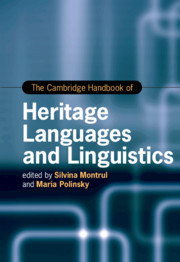Book contents
- The Cambridge Handbook of Heritage Languages and Linguistics
- Cambridge Handbooks In Language And Linguistics
- The Cambridge Handbook of Heritage Languages and Linguistics
- Copyright page
- Dedication
- Contents
- Figures and Tables
- Contributors
- Acknowledgments
- Introduction
- Part I Heritage Languages around the World
- Part II Research Approaches to Heritage Languages
- 15 Heritage Language Research and Theoretical Linguistics
- 16 The Emergence of Heritage Language
- 17 Sociolinguistic Approaches to Heritage Languages
- 18 The Psycholinguistics of Heritage Languages
- 19 Contact Linguistics and Heritage Languages
- 20 A Narrative-Ethnographic Approach to Research on Heritage Language Development
- 21 Corpus-Based Methodologies in the Study of Heritage Languages
- 22 Current Trends and Emerging Methodologies in Charting Heritage Language Grammars
- Part III Grammatical Aspects of Heritage Languages
- Part IV Heritage Language Education
- Index
- References
16 - The Emergence of Heritage Language
A Case Study from Korean*
from Part II - Research Approaches to Heritage Languages
Published online by Cambridge University Press: 04 November 2021
- The Cambridge Handbook of Heritage Languages and Linguistics
- Cambridge Handbooks In Language And Linguistics
- The Cambridge Handbook of Heritage Languages and Linguistics
- Copyright page
- Dedication
- Contents
- Figures and Tables
- Contributors
- Acknowledgments
- Introduction
- Part I Heritage Languages around the World
- Part II Research Approaches to Heritage Languages
- 15 Heritage Language Research and Theoretical Linguistics
- 16 The Emergence of Heritage Language
- 17 Sociolinguistic Approaches to Heritage Languages
- 18 The Psycholinguistics of Heritage Languages
- 19 Contact Linguistics and Heritage Languages
- 20 A Narrative-Ethnographic Approach to Research on Heritage Language Development
- 21 Corpus-Based Methodologies in the Study of Heritage Languages
- 22 Current Trends and Emerging Methodologies in Charting Heritage Language Grammars
- Part III Grammatical Aspects of Heritage Languages
- Part IV Heritage Language Education
- Index
- References
Summary
This chapter outlines an emergentist approach to understanding why human languages have the particular properties that they do and how those properties are acquired by children. Drawing on a variety of examples, it illustrates the role of two factors in shaping language and its acquisition: limitations on the resources available for processing utterances in real time, and the role of input in facilitating the acquisition of particular words and patterns. Both these factors fit well with a key claim of linguistic emergentism, which is that the human language faculty is shaped by forces – cognition, perception, memory, computation, and experience – that are not themselves linguistic in character. The emergentist approach thus provides an alternative to theories that attribute the unique human ability to learn and use language to an inborn Universal Grammar. The second line of inquiry pursued investigates the emergence of particular features of Korean, especially reflexive pronouns and relative clauses, in child and adult heritage learners. The developmental profile associated with these phenomena fits well with the emergentist approach to language, and helps confirm that heritage languages are learned in essentially the same way as languages that are acquired in a monolingual setting.
- Type
- Chapter
- Information
- The Cambridge Handbook of Heritage Languages and Linguistics , pp. 399 - 422Publisher: Cambridge University PressPrint publication year: 2021

